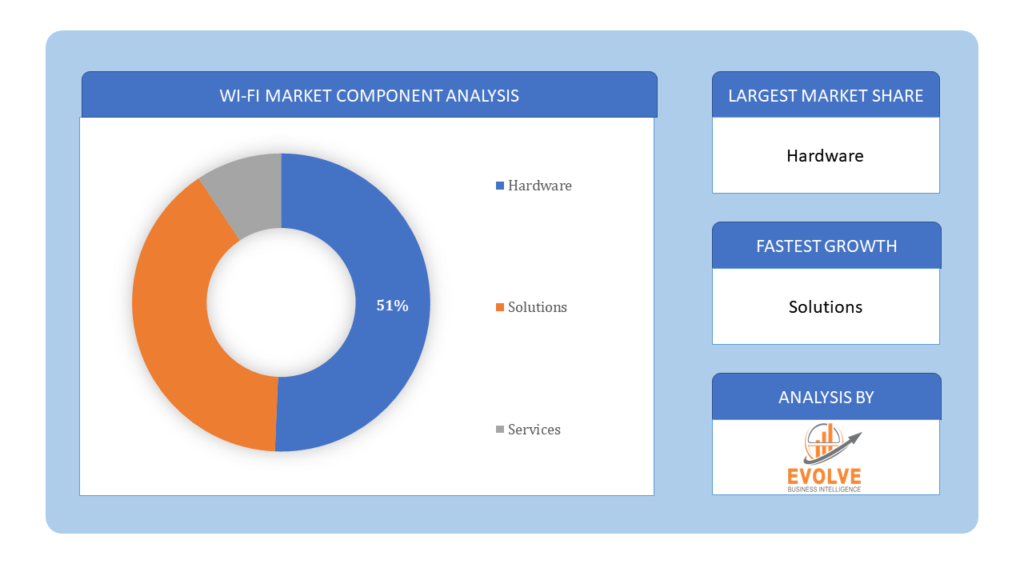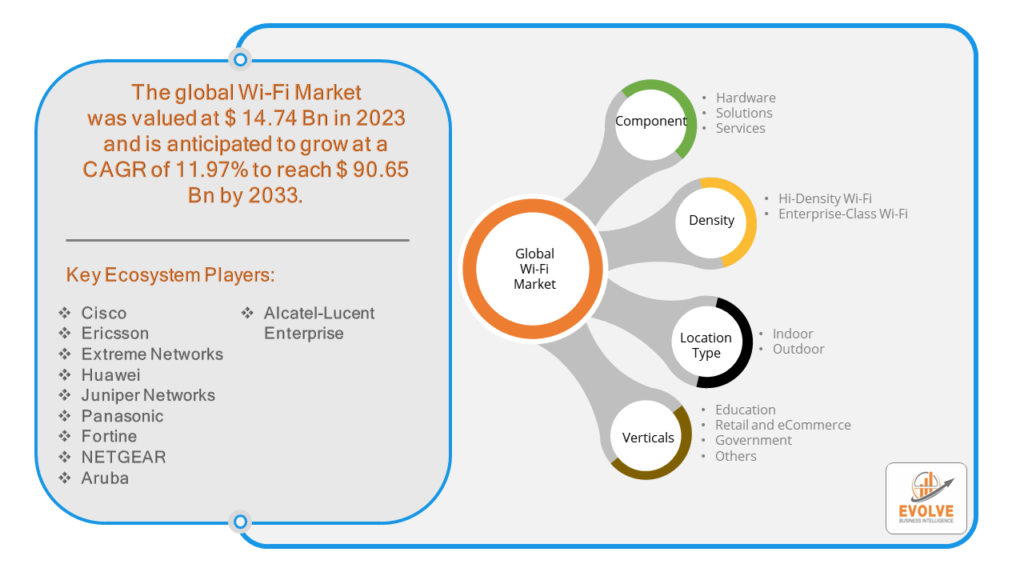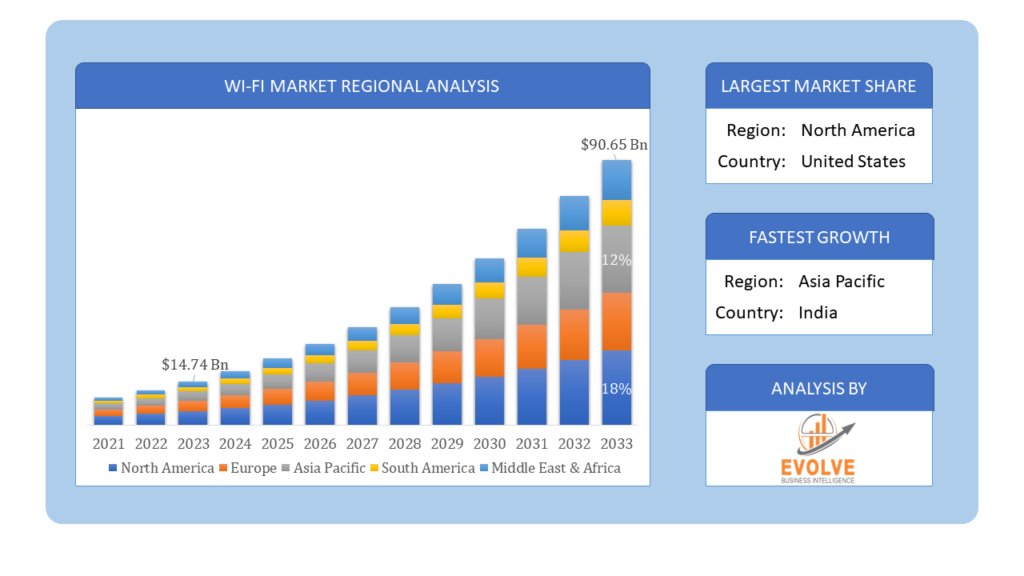Wi-Fi Market Analysis and Global Forecast 2023-2033
$ 1,390.00 – $ 5,520.00Price range: $ 1,390.00 through $ 5,520.00
Wi-Fi Market Research Report: By Component (Hardware, Solutions, Services), By Density ( Hi-Density Wi-Fi, Enterprise-Class Wi-Fi), By Location Type(Indoor, Outdoor), By Verticals(Education, Retail and eCommerce, Government, Others), and by Region — Forecast till 2033
Page: 161
Wi-Fi Market Overview
Wi-Fi Market Size is expected to reach USD 90.65 Billion by 2033. The Wi-Fi industry size accounted for USD 14.74 Billion in 2023 and is expected to expand at a compound annual growth rate (CAGR) of 11.97% from 2023 to 2033. The Wi-Fi market encompasses the global industry involved in the development, production, and distribution of wireless networking technology. This market includes hardware such as routers, access points, and network interface cards, as well as software for network management and security. Key players range from large tech companies to specialized networking firms. Growth in the Wi-Fi market is driven by increasing internet usage, demand for high-speed connectivity, and the proliferation of smart devices and IoT applications. The market is also influenced by advancements in Wi-Fi standards, such as Wi-Fi 6 and 6E, which offer improved performance and efficiency.
Global Wi-Fi Market Synopsis
The COVID-19 pandemic has led to supply chain disruptions leading to supply shortages or lower demand in the Wi-Fi market. The travel restrictions and social-distancing measures have resulted in a sharp drop in consumer and business spending and this pattern is to continue for some time. The end-user trend and preferences have changed due to the pandemic and have resulted in manufacturers, developers, and service providers to adopt various strategies to stabilize the company.
Global Wi-Fi Market Dynamics
The major factors that have impacted the growth of Wi-Fi are as follows:
Drivers:
⮚ Technological Advancements in Wi-Fi Standards
Continuous advancements in Wi-Fi technology, such as the development of Wi-Fi 6 (802.11ax) and Wi-Fi 6E, have significantly enhanced network performance, capacity, and efficiency. These new standards offer higher data rates, reduced latency, and better performance in congested environments, making them highly attractive for both consumers and enterprises.
Restraint:
- High Deployment and Maintenance Costs
Deploying and maintaining advanced Wi-Fi networks, especially in large enterprises or extensive public areas, can be expensive. Costs include purchasing hardware, such as routers and access points, installing network infrastructure, and ongoing maintenance and upgrades. Small and medium-sized enterprises (SMEs) and organizations in developing regions may find these costs prohibitive, limiting their ability to implement robust Wi-Fi solutions.
Opportunity:
⮚ Competition from Alternative Wireless Technologies
Wi-Fi faces competition from other wireless communication technologies, notably cellular networks (4G, 5G) and emerging solutions like Li-Fi (light fidelity). Cellular networks offer extensive coverage and high mobility, making them suitable for outdoor and large-scale deployments. As 5G networks continue to expand, they provide high-speed, low-latency connections that may compete with or complement Wi-Fi in various applications. The presence of these alternatives can limit the market share and growth potential of Wi-Fi solutions.
Wi-Fi Market Segment Overview
By Component
 Based on the Component, the market is segmented based on Hardware, Solutions, Services. The Wi-Fi market is dominated by the hardware segment, which includes components such as access points, routers, and other network devices. This segment holds the highest market share due to the increasing demand for reliable and high-speed wireless connectivity across various industries
Based on the Component, the market is segmented based on Hardware, Solutions, Services. The Wi-Fi market is dominated by the hardware segment, which includes components such as access points, routers, and other network devices. This segment holds the highest market share due to the increasing demand for reliable and high-speed wireless connectivity across various industries
By Density
Based on Density, the market has been divided into Hi-Density Wi-Fi, Enterprise-Class Wi-Fi. The Wi-Fi market is dominated by the Enterprise-Class Wi-Fi segment, which holds the highest market share due to its widespread adoption in high-density environments such as offices and public hotspots
By Location Type
Based on the Location Type, the market has been divided into Indoor, Outdoor. The Wi-Fi market is dominated by the indoor segment, which currently holds a clear dominance in the market
By Verticals
Based on Verticals, the market has been divided into Education, Retail and eCommerce, Government, Others. The retail and e-commerce vertical is also a major contributor to the Wi-Fi market, as businesses in this sector seek to provide reliable wireless connectivity to enhance customer experiences and support growing online sales.
Global Wi-Fi Market Regional Analysis
Based on region, the market has been divided into North America, Europe, Asia-Pacific, the Middle East & Africa, and Latin America. The area of North America is anticipated to dominate the market for the usage of Wi-Fi, followed by those in Asia-Pacific and Europe.
 Wi-Fi North America Market
Wi-Fi North America Market
The North American region holds a dominant position in the Wi-Fi market. Due to the region’s strong player base and broad acceptance of cutting-edge technologies, the North American Wi-Fi as a Service Market will be the largest in the world. Due to the widespread adoption of WaaS solutions in a variety of industries, including healthcare, retail, and hospitality, the United States in particular has seen significant development. The need for WaaS in the area is being driven by the growing number of mobile devices and the requirement for dependable wireless access.
Wi-Fi Asia Pacific Market
The Asia-Pacific region is witnessing rapid growth and emerging as a significant market for the Wi-Fi industry. From 2023 to 2032, the Wi-Fi as a Service Market in Asia-Pacific is anticipated to develop at the quickest rate of compound annual growth. This is brought on by the growing use of smartphones and increased digitization. Significant demand for WaaS solutions is being seen in nations like China, India, Japan, and South Korea in sectors including manufacturing, transportation, and retail. The demand for dependable and expandable Wi-Fi networks is being driven by the region’s high population density and the rising use of mobile devices, which is fueling the market’s expansion.
Competitive Landscape
The competitive landscape includes key players (tier 1, tier 2, and local) having a presence across the globe. Companies such as Cisco, Ericsson, Extreme Networks, Huawei, and Juniper Networks are some of the leading players in the global Wi-Fi Industry. These players have adopted partnership, acquisition, expansion, and new product development, among others as their key strategies.
Key Market Players:
- Cisco
- Ericsson
- Extreme Networks
- Huawei
- Juniper Networks
- Panasonic
- Fortine
- NETGEAR
- Aruba
- Alcatel-Lucent Enterprise
Key Development:
Cisco Meraki’s business internet package and T-Mobile’s cellular gateways are linked together through the Connected Workplace service. To provide managed remote office/branch office (ROBO) 5G connectivity, the companies entered into a joint venture. Connected workplace aims at facilitating quick setup of functional network infrastructure, reducing the pain points most customers face.
Scope of the Report
Global Wi-Fi Market, by Component
- Hardware
- Solutions
- Services
Global Wi-Fi Market, by Density
- Hi-Density Wi-Fi
- Enterprise-Class Wi-Fi
Global Wi-Fi Market, by Location Type
- Indoor
- Outdoor
Global Wi-Fi Market, by Verticals
- Education
- Retail and eCommerce
- Government
- Others
Global Wi-Fi Market, by Region
- North America
- US
- Canada
- Mexico
- Europe
- UK
- Germany
- France
- Italy
- Spain
- Benelux
- Nordic
- Rest of Europe
- Asia Pacific
- China
- Japan
- South Korea
- Indonesia
- Austalia
- Malaysia
- India
- Rest of Asia Pacific
- South America
- Brazil
- Argentina
- Rest of South America
- Middle East & Africa
- Saudi Arabia
- UAE
- Egypt
- South Africa
- Rest of Middle East & Africa
| Parameters | Indicators |
|---|---|
| Market Size | 2033: $90.65 Billion |
| CAGR | 11.97% CAGR (2023-2033) |
| Base year | 2022 |
| Forecast Period | 2023-2033 |
| Historical Data | 2021 |
| Report Coverage | Revenue Forecast, Competitive Landscape, Growth Factors, and Trends |
| Key Segmentations | Component, Density, Location Type, Verticals |
| Geographies Covered | North America, Europe, Asia-Pacific, Latin America, Middle East, Africa |
| Key Vendors | Cisco, Ericsson, Extreme Networks, Huawei, Juniper Networks, Panasonic, Fortine, NETGEAR, Aruba, Alcatel-Lucent Enterprise |
| Key Market Opportunities | With the high adaptation of advanced new technology, small and medium enterprises require automated, cost-efficient, flexible, and scalable Wi-Fi networks |
| Key Market Drivers | Wi-Fi Market also provide end-to-end prominence and quicker placement |
REPORT CONTENT BRIEF:
- High-level analysis of the current and future Wi-Fi Industry trends and opportunities
- Detailed analysis of current market drivers, restraining factors, and opportunities analysis in the future
- Historical market size for the year 2021, and forecast from 2023 to 2033
- Wi-Fi market share analysis for each segment
- Competitor analysis with a comprehensive insight into its product segment, financial strength, and strategies adopted.
- Identifies key strategies adopted by the key players including new product development, mergers and acquisitions, joint ventures, collaborations, and partnerships.
- To identify and understand the various factors involved in the global Wi-Fi market affected by the pandemic
- To provide year-on-year growth from 2022 to 2033
- To provide short-term, long-term, and overall CAGR comparison from 2022 to 2033.
- Provide Total Addressable Market (TAM) for the Global Wi-Fi Market.
Press Release

Global Pharmaceutical Manufacturing Market to Reach $1.38 Trillion by 2035 with 7.35% CAGR, New Research Shows

The Global Mammography Market Is Estimated To Record a CAGR of Around 10.29% During The Forecast Period

Glue Stick Market to Reach USD 2.35 Billion by 2034

Podiatry Service Market to Reach USD 11.88 Billion by 2034

Microfluidics Technology Market to Reach USD 32.58 Billion by 2034

Ferric Chloride Market to Reach USD 10.65 Billion by 2034

Family Practice EMR Software Market to Reach USD 21.52 Billion by 2034

Electric Hairbrush Market to Reach USD 15.95 Billion by 2034

Daily Bamboo Products Market to Reach USD 143.52 Billion by 2034

Cross-border E-commerce Logistics Market to Reach USD 112.65 Billion by 2034
Frequently Asked Questions (FAQ)
1.What is the study period of this market?
- The study period of the global Wi-Fi market is 2022- 2033
2.What are the 10 Years CAGR (2023 to 2033) of the global Wi-Fi market?
- The global Wi-Fi market is growing at a CAGR of ~97% over the next 10 years
3.Which region has the highest growth rate in the market of Wi-Fi?
- Asia Pacific is expected to register the highest CAGR during 2023-2033
4.Which region accounted for the largest share of the market of Wi-Fi?
- North America holds the largest share in 2022
5.Major Key Players in the Market of Wi-Fi?
Cisco, Ericsson, Extreme Networks, Huawei, Juniper Networks, Panasonic, Fortine, NETGEAR, Aruba, and Alcatel-Lucent Enterprise are the major companies operating in the Wi-Fi Industry
6.Do you offer Post Sale Support?
- Yes, we offer 16 hours of analyst support to solve the queries
7.Do you deliver sections of a report?
Yes, we do provide regional as well as country-level reports. Other than this we also provide a sectional report. Please get in contact with our sales representatives
Table of Content
CHAPTER 1. Executive Summary CHAPTER 2. Scope of the Study 2.1. Market Definition 2.2. Market Scope & Segmentation 2.2.1. Objective of Report CHAPTER 3. Evolve BI Methodology 3.1. Data Collection & Validation Approach 3.2. Market Size Estimation and Forecast CHAPTER 4. Exclusive Analysis 4.1. Market Opportunity Score 4.1.1. Component Segement – Market Opportunity Score 4.1.2. Density Segment – Market Opportunity Score 4.1.3. Location Type Segment – Market Opportunity Score 4.1.4. Verticals Segment – Market Opportunity Score 4.2. Key Market Influencing Indicators CHAPTER 5. Market Insights and Trends 5.1. Value Chain Analysis 5.1.1. Component 5.1.2. Manufacturing Process 5.1.3. Distribution Channel 5.1.4. End User 5.2. Porter’s Five Forces Analysis 5.2.1. Bargaining Power of Buyers 5.2.2. Bargaining Power of Suppliers 5.2.3. Threat of New Entrant 5.2.4. Threat of Substitute 5.2.5. Industry Rivalry 5.3. COVID-19 Impact and Post COVID Scenario on Wi-Fi Market 5.3.1. Impact of COVID-19 5.3.2. Government Support and Industry Revival Policies 5.3.3. Measures Taken by Companies to Mitigate Negative Impact 5.3.4. Post COVID Trend CHAPTER 6. MArket Dynamics 6.1. Introduction 6.2. Drivers 6.2.1. Driver 1 6.2.2. Driver 2 6.2.3. Driver 3 6.3. Restraints 6.3.1. Restraint 1 6.3.2. Restraint 2 6.4. Opportunity 6.4.1. Opportunity 1 CHAPTER 7. Global Wi-Fi Market, By Component 7.1. Introduction 7.1.1. Hardware 7.1.2. Solutions 7.1.3. Services CHAPTER 8. Global Wi-Fi Market, By Density 8.1. Introduction 8.1.1. Hi-Density Wi-Fi 8.1.2. Enterprise-Class Wi-Fi 8.1.3. Density3 8.1.4. Density4 CHAPTER 9. Global Wi-Fi Market, By Location Type 9.1. Introduction 9.1.1. Indoor 9.1.2. Outdoor CHAPTER 10. Global Wi-Fi Market, By Verticals 10.1. Introduction 10.1.1. Education 10.1.2. Retail and eCommerce 10.1.3. Government 101.4. Others CHAPTER 11. Global Wi-Fi Market, By Region 11.1. Introduction 11.2. NORTH AMERICA 11.2.1. North America: Market Size and Forecast, By Country, 2023 – 2033 ($ Million) 11.2.2. North America: Market Size and Forecast, By Component, 2023 – 2033 ($ Million) 11.2.3. North America: Market Size and Forecast, By Density, 2023 – 2033 ($ Million) 11.2.4. North America: Market Size and Forecast, By Location Type, 2023 – 2033 ($ Million) 11.2.5. North America: Market Size and Forecast, By Verticals, 2023 – 2033 ($ Million) 11.2.6. US 11.2.6.1. US: Market Size and Forecast, By Component, 2023 – 2033 ($ Million) 11.2.6.2. US: Market Size and Forecast, By Density, 2023 – 2033 ($ Million) 11.2.6.3. US: Market Size and Forecast, By Location Type, 2023 – 2033 ($ Million) 11.2.6.4. US: Market Size and Forecast, By Verticals, 2023 – 2033 ($ Million) 11.2.7. CANADA 11.2.7.1. Canada: Market Size and Forecast, By Component, 2023 – 2033 ($ Million) 11.2.7.2. Canada: Market Size and Forecast, By Density, 2023 – 2033 ($ Million) 11.2.7.3. Canada: Market Size and Forecast, By Location Type, 2023 – 2033 ($ Million) 11.2.7.4. Canada: Market Size and Forecast, By Verticals, 2023 – 2033 ($ Million) 11.2.8. MEXICO 11.2.8.1. Mexico: Market Size and Forecast, By Component, 2023 – 2033 ($ Million) 11.2.8.2. Mexico: Market Size and Forecast, By Density, 2023 – 2033 ($ Million) 11.2.8.3. Mexico: Market Size and Forecast, By Location Type, 2023 – 2033 ($ Million) 11.2.8.4. Mexico: Market Size and Forecast, By Verticals, 2023 – 2033 ($ Million) 11.3. Europe 11.3.1. Europe: Market Size and Forecast, By Country, 2023 – 2033 ($ Million) 11.3.2. Europe: Market Size and Forecast, By Component, 2023 – 2033 ($ Million) 11.3.3. Europe: Market Size and Forecast, By Density, 2023 – 2033 ($ Million) 11.3.4. Europe: Market Size and Forecast, By Location Type, 2023 – 2033 ($ Million) 11.3.5. Europe: Market Size and Forecast, By Verticals, 2023 – 2033 ($ Million) 11.3.6. U.K. 11.3.6.1. U.K.: Market Size and Forecast, By Component, 2023 – 2033 ($ Million) 11.3.6.2. U.K.: Market Size and Forecast, By Density, 2023 – 2033 ($ Million) 11.3.6.3. U.K.: Market Size and Forecast, By Location Type, 2023 – 2033 ($ Million) 11.3.6.4. U.K.: Market Size and Forecast, By Verticals, 2023 – 2033 ($ Million) 11.3.7. GERMANY 11.3.7.1. Germany: Market Size and Forecast, By Component, 2023 – 2033 ($ Million) 11.3.7.2. Germany: Market Size and Forecast, By Density, 2023 – 2033 ($ Million) 11.3.7.3. Germany: Market Size and Forecast, By Location Type, 2023 – 2033 ($ Million) 11.3.7.4. Germany: Market Size and Forecast, By Verticals, 2023 – 2033 ($ Million) 11.3.8. FRANCE 11.3.8.1. France: Market Size and Forecast, By Component, 2023 – 2033 ($ Million) 11.3.8.2. France: Market Size and Forecast, By Density, 2023 – 2033 ($ Million) 11.3.8.3. France: Market Size and Forecast, By Location Type, 2023 – 2033 ($ Million) 11.3.8.4. France: Market Size and Forecast, By Verticals, 2023 – 2033 ($ Million) 11.3.9. ITALY 11.3.9.1. Italy: Market Size and Forecast, By Component, 2023 – 2033 ($ Million) 11.3.9.2. Italy: Market Size and Forecast, By Density, 2023 – 2033 ($ Million) 11.3.9.3. Italy: Market Size and Forecast, By Location Type, 2023 – 2033 ($ Million) 11.3.9.4. Italy: Market Size and Forecast, By Verticals, 2023 – 2033 ($ Million) 11.3.10. SPAIN 11.3.10.1. Spain: Market Size and Forecast, By Component, 2023 – 2033 ($ Million) 11.3.10.2. Spain: Market Size and Forecast, By Density, 2023 – 2033 ($ Million) 11.3.10.3. Spain: Market Size and Forecast, By Location Type, 2023 – 2033 ($ Million) 11.3.10.4. Spain: Market Size and Forecast, By Verticals, 2023 – 2033 ($ Million) 11.3.11. BENELUX 11.3.11.1. BeNeLux: Market Size and Forecast, By Component, 2023 – 2033 ($ Million) 11.3.11.2. BeNeLux: Market Size and Forecast, By Density, 2023 – 2033 ($ Million) 11.3.11.3. BeNeLux: Market Size and Forecast, By Location Type, 2023 – 2033 ($ Million) 11.3.11.4. BeNeLux: Market Size and Forecast, By Verticals, 2023 – 2033 ($ Million) 11.3.12. RUSSIA 11.3.12.1. Russia: Market Size and Forecast, By Component, 2023 – 2033 ($ Million) 11.3.12.2. Russia: Market Size and Forecast, By Density, 2023 – 2033 ($ Million) 11.3.12.3. Russia: Market Size and Forecast, By Location Type, 2023 – 2033 ($ Million) 11.3.12.4. Russia: Market Size and Forecast, By Verticals, 2023 – 2033 ($ Million) 11.3.13. REST OF EUROPE 11.3.13.1. Rest of Europe: Market Size and Forecast, By Component, 2023 – 2033 ($ Million) 11.3.13.2. Rest of Europe: Market Size and Forecast, By Density, 2023 – 2033 ($ Million) 11.3.13.3. Rest of Europe: Market Size and Forecast, By Location Type, 2023 – 2033 ($ Million) 11.3.13.4. Rest of Europe: Market Size and Forecast, By Verticals, 2023 – 2033 ($ Million) 11.4. Asia Pacific 11.4.1. Asia Pacific: Market Size and Forecast, By Country, 2023 – 2033 ($ Million) 11.4.2. Asia Pacific: Market Size and Forecast, By Component, 2023 – 2033 ($ Million) 11.4.3. Asia Pacific: Market Size and Forecast, By Density, 2023 – 2033 ($ Million) 11.4.4. Asia Pacific: Market Size and Forecast, By Location Type, 2023 – 2033 ($ Million) 11.4.5. Asia Pacific: Market Size and Forecast, By Verticals, 2023 – 2033 ($ Million) 11.4.6. CHINA 11.4.6.1. China: Market Size and Forecast, By Component, 2023 – 2033 ($ Million) 11.4.6.2. China: Market Size and Forecast, By Density, 2023 – 2033 ($ Million) 11.4.6.3. China: Market Size and Forecast, By Location Type, 2023 – 2033 ($ Million) 11.4.6.4. China: Market Size and Forecast, By Verticals, 2023 – 2033 ($ Million) 11.4.7. JAPAN 11.4.7.1. Japan: Market Size and Forecast, By Component, 2023 – 2033 ($ Million) 11.4.7.2. Japan: Market Size and Forecast, By Density, 2023 – 2033 ($ Million) 11.4.7.3. Japan: Market Size and Forecast, By Location Type, 2023 – 2033 ($ Million) 11.4.7.4. Japan: Market Size and Forecast, By Verticals, 2023 – 2033 ($ Million) 11.4.8. INDIA 11.4.8.1. India: Market Size and Forecast, By Component, 2023 – 2033 ($ Million) 11.4.8.2. India: Market Size and Forecast, By Density, 2023 – 2033 ($ Million) 11.4.8.3. India: Market Size and Forecast, By Location Type, 2023 – 2033 ($ Million) 11.4.8.4. India: Market Size and Forecast, By Verticals, 2023 – 2033 ($ Million) 11.4.9. SOUTH KOREA 11.4.9.1. South Korea: Market Size and Forecast, By Component, 2023 – 2033 ($ Million) 11.4.9.2. South Korea: Market Size and Forecast, By Density, 2023 – 2033 ($ Million) 11.4.9.3. South Korea: Market Size and Forecast, By Location Type, 2023 – 2033 ($ Million) 11.4.9.4. South Korea: Market Size and Forecast, By Verticals, 2023 – 2033 ($ Million) 11.4.10. THAILAND 11.4.10.1. Thailand: Market Size and Forecast, By Component, 2023 – 2033 ($ Million) 11.4.10.2. Thailand: Market Size and Forecast, By Density, 2023 – 2033 ($ Million) 11.4.10.3. Thailand: Market Size and Forecast, By Location Type, 2023 – 2033 ($ Million) 11.4.10.4. Thailand: Market Size and Forecast, By Verticals, 2023 – 2033 ($ Million) 11.4.11. INDONESIA 11.4.11.1. Indonesia: Market Size and Forecast, By Component, 2023 – 2033 ($ Million) 11.4.11.2. Indonesia: Market Size and Forecast, By Density, 2023 – 2033 ($ Million) 11.4.11.3. Indonesia: Market Size and Forecast, By Location Type, 2023 – 2033 ($ Million) 11.4.11.4. Indonesia: Market Size and Forecast, By Verticals, 2023 – 2033 ($ Million) 11.4.12. MALAYSIA 11.4.12.1. Malaysia: Market Size and Forecast, By Component, 2023 – 2033 ($ Million) 11.4.12.2. Malaysia: Market Size and Forecast, By Density, 2023 – 2033 ($ Million) 11.4.12.3. Malaysia: Market Size and Forecast, By Location Type, 2023 – 2033 ($ Million) 11.4.12.4. Malaysia: Market Size and Forecast, By Verticals, 2023 – 2033 ($ Million) 11.4.13. AUSTRALIA 11.4.13.1. Australia: Market Size and Forecast, By Component, 2023 – 2033 ($ Million) 11.4.13.2. Australia: Market Size and Forecast, By Density, 2023 – 2033 ($ Million) 11.4.13.3. Australia: Market Size and Forecast, By Location Type, 2023 – 2033 ($ Million) 11.4.13.4. Australia: Market Size and Forecast, By Verticals, 2023 – 2033 ($ Million) 11.4.14. REST FO ASIA PACIFIC 11.4.14.1. Rest fo Asia Pacific: Market Size and Forecast, By Component, 2023 – 2033 ($ Million) 11.4.14.2. Rest fo Asia Pacific: Market Size and Forecast, By Density, 2023 – 2033 ($ Million) 11.4.14.3. Rest fo Asia Pacific: Market Size and Forecast, By Location Type, 2023 – 2033 ($ Million) 11.4.14.4. Rest fo Asia Pacific: Market Size and Forecast, By Verticals, 2023 – 2033 ($ Million) 11.5. South America 11.5.1. South America: Market Size and Forecast, By Country, 2023 – 2033 ($ Million) 11.5.2. South America: Market Size and Forecast, By Component, 2023 – 2033 ($ Million) 11.5.3. South America: Market Size and Forecast, By Density, 2023 – 2033 ($ Million) 11.5.4. South America: Market Size and Forecast, By Location Type, 2023 – 2033 ($ Million) 11.5.5. South America: Market Size and Forecast, By Verticals, 2023 – 2033 ($ Million) 11.5.6. BRAZIL 11.5.6.1. Brazil: Market Size and Forecast, By Component, 2023 – 2033 ($ Million) 11.5.6.2. Brazil: Market Size and Forecast, By Density, 2023 – 2033 ($ Million) 11.5.6.3. Brazil: Market Size and Forecast, By Location Type, 2023 – 2033 ($ Million) 11.5.6.4. Brazil: Market Size and Forecast, By Verticals, 2023 – 2033 ($ Million) 11.5.7. ARGENTINA 11.5.7.1. Argentina: Market Size and Forecast, By Component, 2023 – 2033 ($ Million) 11.5.7.2. Argentina: Market Size and Forecast, By Density, 2023 – 2033 ($ Million) 11.5.7.3. Argentina: Market Size and Forecast, By Location Type, 2023 – 2033 ($ Million) 11.5.7.4. Argentina: Market Size and Forecast, By Verticals, 2023 – 2033 ($ Million) 11.5.8. REST OF SOUTH AMERICA 11.5.8.1. Rest of South America: Market Size and Forecast, By Component, 2023 – 2033 ($ Million) 11.5.8.2. Rest of South America: Market Size and Forecast, By Density, 2023 – 2033 ($ Million) 11.5.8.3. Rest of South America: Market Size and Forecast, By Location Type, 2023 – 2033 ($ Million) 11.5.8.4. Rest of South America: Market Size and Forecast, By Verticals, 2023 – 2033 ($ Million) 11.6. Middle East & Africa 11.6.1. Middle East & Africa: Market Size and Forecast, By Country, 2023 – 2033 ($ Million) 11.6.2. Middle East & Africa: Market Size and Forecast, By Component, 2023 – 2033 ($ Million) 11.6.3. Middle East & Africa: Market Size and Forecast, By Density, 2023 – 2033 ($ Million) 11.6.4. Middle East & Africa: Market Size and Forecast, By Location Type, 2023 – 2033 ($ Million) 11.6.5. Middle East & Africa: Market Size and Forecast, By Verticals, 2023 – 2033 ($ Million) 11.6.6. SAUDI ARABIA 11.6.6.1. Saudi Arabia: Market Size and Forecast, By Component, 2023 – 2033 ($ Million) 11.6.6.2. Saudi Arabia: Market Size and Forecast, By Density, 2023 – 2033 ($ Million) 11.6.6.3. Saudi Arabia: Market Size and Forecast, By Location Type, 2023 – 2033 ($ Million) 11.6.6.4. Saudi Arabia: Market Size and Forecast, By Verticals, 2023 – 2033 ($ Million) 11.6.7. UAE 11.6.7.1. UAE: Market Size and Forecast, By Component, 2023 – 2033 ($ Million) 11.6.7.2. UAE: Market Size and Forecast, By Density, 2023 – 2033 ($ Million) 11.6.7.3. UAE: Market Size and Forecast, By Location Type, 2023 – 2033 ($ Million) 11.6.7.4. UAE: Market Size and Forecast, By Verticals, 2023 – 2033 ($ Million) 11.6.8. EGYPT 11.6.8.1. Egypt: Market Size and Forecast, By Component, 2023 – 2033 ($ Million) 11.6.8.2. Egypt: Market Size and Forecast, By Density, 2023 – 2033 ($ Million) 11.6.8.3. Egypt: Market Size and Forecast, By Location Type, 2023 – 2033 ($ Million) 11.6.8.4. Egypt: Market Size and Forecast, By Verticals, 2023 – 2033 ($ Million) 11.6.9. SOUTH AFRICA 11.6.9.1. South Africa: Market Size and Forecast, By Component, 2023 – 2033 ($ Million) 11.6.9.2. South Africa: Market Size and Forecast, By Density, 2023 – 2033 ($ Million) 11.6.9.3. South Africa: Market Size and Forecast, By Location Type, 2023 – 2033 ($ Million) 11.6.9.4. South Africa: Market Size and Forecast, By Verticals, 2023 – 2033 ($ Million) 11.6.10. REST OF MIDDLE EAST & AFRICA 11.6.10.1. Rest of Middle East & Africa: Market Size and Forecast, By Component, 2023 – 2033 ($ Million) 11.6.10.2. Rest of Middle East & Africa: Market Size and Forecast, By Density, 2023 – 2033 ($ Million) 11.6.10.3. Rest of Middle East & Africa: Market Size and Forecast, By Location Type, 2023 – 2033 ($ Million) 11.6.10.4. Rest of Middle East & Africa: Market Size and Forecast, By Verticals, 2023 – 2033 ($ Million) CHAPTER 12. Competitive Landscape 12.1. Competitior Benchmarking 2023 12.2. Market Share Analysis 12.3. Key Developments Analysis By Top 5 Companies 12.4. Market Share Acquisition Strategies: Analysis of Key Approaches Employed by Top Players CHAPTER 13. Company Profiles 13.1. Cisco 13.1.1. Business Overview 13.1.2. Financial Analysis 13.1.2.1. Business Segment Revenue, 2018, 2019, 2020, $ Million 13.1.2.2. Geographic Revenue Mix, 2020 (% Share) 13.1.3. Product Portfolio 13.1.4. Recent Development and Strategies Adopted 13.1.5. SWOT Analysis 13.2. Ericsson 13.3. Extreme Networks 13.4. Huawei 13.5. Juniper Networks 13.6. Panasonic 13.7. Fortine 13.8. NETGEAR 13.9. Aruba 13.10. Alcatel-Lucent Enterprise
Connect to Analyst
Research Methodology








